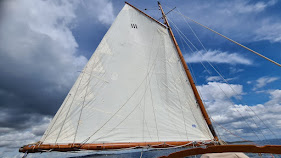Following our initial day sails, I have now spent several days aboard to implement the completion of winter projects put off during the first Covid-19 lockdown. The second lockdown has given the opportunity to study the internet in depth to resolve our 12 V power requirements and charging.


 Not all electrics, also an opportunity to tidy up the mainsail and admire the new lazy jacks, fitting a temporary third one.
Not all electrics, also an opportunity to tidy up the mainsail and admire the new lazy jacks, fitting a temporary third one.The Sunware 36 watt panel had clearly, with visible damage, stopped working last season, if not in 2019 but careful deployment of the one -both-two switch ensured that both sets of batteries were charged at the end of a day, sufficiently to restart the engine, the following day. With her new Beta 30 engine she has a standard 75 amp, internally regulated, alternator with multi-v belt drive. It appears that this replenishes the few amps drawn in from the start battery with in minutes, if not seconds. So an early switch to 2, while helpful, has still meant that there is not, then, a three staged charging of the, often, 25% depleted house batteries.
It became clear that, rather than a simple charge relay, as recommended by a local marine electrician in 2018, who never had time to start the job, a DC to DC charger would be a better option. It would achieve a multi stage charge for any specific battery chemistry, including the sealed lead AGM's replaced in 2017, or even Lithium Ion if ever affordable. Given that the FLA starting battery and alternator is similar to a set up in a car and is almost always 100% charged, a greater excess from the alternator could be drawn by the DC-DC charger and used to power the variable charging needs of the AGM house batteries more rapidly. Alternator over heating would be unlikely except for Lithium batteries.
By moving the 1100 watt 250v ac inverter, that came with the boat, by one inch, there was room to mount the Victron device on the bulkhead between the two lockers under the quarter berth, leaving room for three busbars, two +ve for each battery and one -ve for both. The existing Stirling mains battery charger, which already uses a three stage algorithm, is retained but the isolation switch for the inverter was replaced and re sited. The opportunity was taken to install a fuse for each battery in the battery compartment to replace the single fuse for the house batteries, while retaining the separate fuse to the inverter. The starting battery was never fused to the mains charger!
Another delayed project was to try and reduce the apparent 0.3v drop at the DC panel. Replacing the untinned 4mm wire to the panel with 16 mm2 tinned wire from a 30 amp trip near to the battery and accessible under the companion way step. The "one-both two" battery switch is retained but can be left permanently on "one", the starting battery as it is always isolated unless the DC-DC charger detects the engine is running and more than 13 V. There is still the facility to start the engine on the house batteries if the start battery fails or needs a boost. Experience in our first season, demonstrated the inadvisability of combining AGM with FLA batteries, so "both" has not been used for a while.
The damaged Sunware solar panel had already been removed, the deck made good and painted by Julie. A near similar sized, semiflexible, panel from the same manufacture but capable of 60 watts output, was refitted with industrial velcro tape under most of it's area, to assist easier replacement in future. This has stayed in place so far and may introduce some cooling. The old Fox 100 PWM solar charge controller was replaced with a Victron MPPT controller and isolating switch. All now connected to the new bus under the chart table with a fuse.
Early indications suggest that after a few days of sunshine at this time of year the house batteries are fully charged on float, anyway, if not they receive more absorption charge while under engine, although many hours would still be required to fully charge. The 250 V AC shore power and outlets remain and may be used kore, via the inverter, for charging power tools etc.
A four fuse block is now attached to the +ve of the house bank with blade fuses for "always on", bilge pump, switch, CO/LPG alarm and constant 12v for the fm wireless.
The engine starting wires have been left intact retaining "one-both-two" for emergencies. The only thing remaining is the connection between the original, much simplified -ve bus bar in the battery compartment and the engine block. Like the starter connecting cables they are untinned and need reviewing. The actual connections to the starter are inaccessible without lifting the engine, which involves removing the heat exchanger, probably above my pay grade!
















































